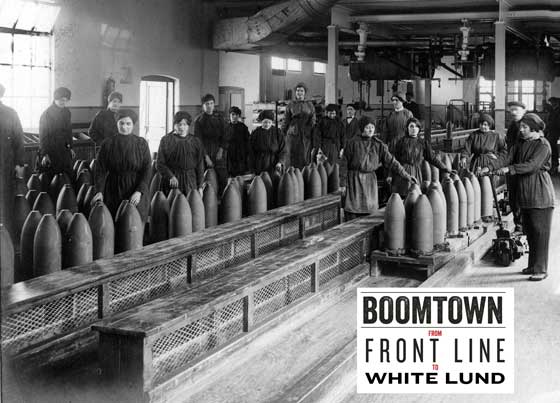The Great War Centenary
1917 - ExhibitionBoomtown - From
Front Line to White Lund
Time Line of the 1st October 1917

Monday 1st October 1917
Around 6.00 pm
Nightshift begins for around 2000 workers. Some staff (site engineers)
start a little earlier for site checks.
6.40 pm
Works firemen completed their regular fire drill.
9 – 9.40 pm
12” shells filled with TNT mix in Unit 6C. Other shells filled in other
units.
10.00 pm
Supper break.
Around 10.15 pm
Fire noticed by various eye witnesses - “flames issuing from the roof of
No. 6 Stemming House”
Sprinklers turned on, on runways and firemen and workers start to tackle
the fire.
Workers rushed to Main Gate which, at this stage, is closed.
Change houses opened for workers to escape the danger zone.
Car sent for Mr Stokes, General Manager. Gates opened, workers rushed
out.
Cannot contact Lancaster Fire Brigade by phone – the lines are dead.
Around 10.30 pm
Large explosion heard as far away as Nelson. Multiple small fires
developed. Shells exploding.
Site electricity failed – including the electric water pump. Only light
is moonlight and that provided by fires.
Petrol powered water pump still working and valve is opened to access
Lancaster’s town water supply.
10.45 pm
Car sent to contact Lancaster Fire Brigade.
Explosions continue throughout the night. Chief Constable in Blackpool
records hearing and feeling a violent explosion and contacting Lancaster
Police to offer support from Fire and Ambulance staff.
Thomas Kew and Abraham Graham moved railway wagons filled with shells
out of the danger zone.
By 11.00 pm
Lancaster and Morecambe Fire Brigades arrived on or near site.
Morecambe’s engine was horse drawn. Seeing the horses were at risk of
injury and were frightened by the explosions, the Chief Officer of
Morecambe withdrew from the site around 2.00 am to take guard of the
town in case of need. At this point White Lund was no place for horses.
11.10 pm
Firemen, police and workers at Main Gate ordered to take cover – many
stayed under the railway bridge. Site too dangerous. Power House workers
remain in place.
Tuesday 2nd October 1917
2.25 am
Blackpool’s St John’s Ambulance Association ambulance arrived – having
set off from Blackpool at 1.10am.
2.45 am
William Disberry, Pump Manager, blown through window by explosion.
3.00 am
Another huge explosion, heard as far away as Burnley.
3.45 am
The Blackpool ambulance took badly injured workman, William Topping, off
the site where he had been cared for in dangerous conditions by Nurse
Cope. After this the ambulance was asked to ferry women workers back to
their homes/digs in Morecambe.
4.15 am
Car sent to Lancaster to get railway locomotives to remove wagons of
filled shells from site. Two locomotives came, but could not reach
wagons.
6.00 am
Most of the original workers/fire fighters/police relieved.
Dawn
Preston Fire Brigade arrives and works with Lancaster Fire Brigade
flooding the magazines. Low water pressure in main pipe. Firemen fear a
broken main pipe.
Rumour of further massive explosions prevents locals returning home.
Morning
Vickers staff arrive. Workers paid off and many leave for home swiftly –
sometimes without telling anyone. Many were later moved to other filling
factories, including Hereford.
2.40 pm
Blackpool Fire Brigade and ambulance arrive. Manchester Fire Brigade
arrive. Fight fires at Main Gate and Discharge/Change Houses. Water
supply low. Over the next few hours the fire brigades start using water
from ditches and ponds to supplement the supply from the works one
remaining petrol pump.
Preston, Chorley and Barrow fire services flood the TNT Magazines.
3.10 pm
Blackpool ambulance heads home, relieved by Fleetwood and Kendal
ambulances.
Liverpool and Vickers’ Barrow fire engines arrive.
Fulwood fire engine tackled the Charge House fires. Liverpool and
Manchester work at the Bonded Stores.
5.45 pm
Vickers’ Barrow fire engine tackled burning wagons, filled with live
shells.
6.00 pm
Food and fuel arranged for everyone.
Midnight
Fire and explosions concentrated in Melt, Stemming and Transit Sheds
Wednesday 3rd October 1917
Night time
Several fire engines worked together to provide a water supply to enable
them to tackle the fires remaining in the danger zone.
4.00 am
Salford Fire Engine arrived after having had an accident on its way.
4.15 am
The last large explosion. It knocked down several firemen. Acting on the
Work’s Manager’s suggested all fire fighters withdrew till dawn.
5.45 am
Fire fighters resumed work.
Daylight
All fires under control or out. Locals returned home. Much damage.
8.00 am
Ministry of Munitions, Vickers and White Lund Managers and Chief
Officers of all the Fire Brigades met and passed on Winston Churchill’s
(the Minister of Munitions) message of thanks for all the selfless
service given by all.
2.30 pm
Mayor of Lancaster admitted shutting off water supply to site as they
thought water from the sprinklers and mains were running to waste. Water
supply restored.
7 bodies found
4.00 pm
Chorley firemen relieved the Barrow brigade. Barrow and Bolton Fire
Brigades leave for home.
Evening
All fires were out. Cooling work. Rained heavily.
Thursday 4th October 1917
8.00 am
Firemen believed the site was now safe.
12.00 noon
All Fire Brigades, except Lancaster, had left the factory.
© Images are copyright, Trustees of the King's Own Royal Regiment Museum.
You must seek permission prior to
publication of any of our images.
Only a proportion of our collections
are on display at anyone time. Certain items are on loan for display
in other institutions. An appointment is required to consult any of
our collections which are held in store.


